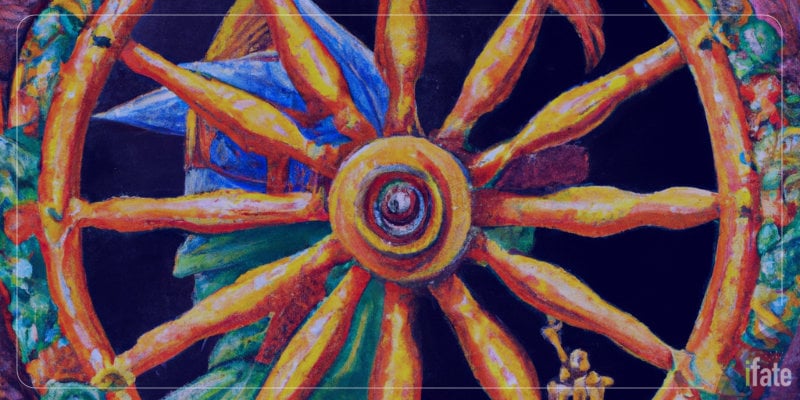Today’s modern Tarot decks are packed with ancient symbols, all of which pre-date the creation of the Tarot itself. One such mysterious symbol is the Rota Fortunae, or “Wheel of Fate”.
What is the Rota Fortunae?
While few people today know the long history of the Rota Fortunae, it was once a common term — and a commonly used visual element in artwork.
Appearing in countless historical illustrations, manuscripts and mosaics from ancient Greece to the medieval period in Europe, the Rota Fortunae is one of the earliest historical representations of Fate.
The symbol serves as an iconic reminder that all fortunes exist in flux, and that fate and fortune ultimately affect us all.
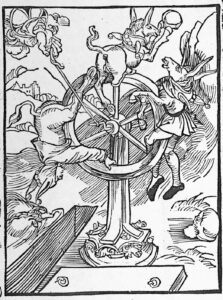
“Rota Fortunae” – Sebastian Brant, 1499 AD.
Typically pictured as a giant wheel, the ever-turning Rota Fortunae inexorably lifts and lowers the fates of everything and everyone, including individuals, politicians, dynasties and nations. It was often used in political cartoons, woodcuts, and early printed-books. The wheel reminds us all that socially, politically and economically, what goes up, must come down — and vice versa.
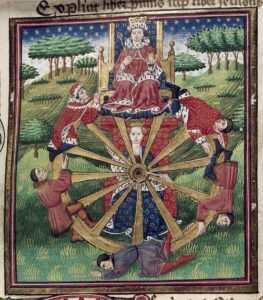
“The Wheel of Fortune”, 1457 AD.
While the name “Rota Fortunae” references the Roman-era goddess of luck “Fortunae” (who was sometimes depicted holding the wheel as shown below) the origins of the Wheel of Fate concept go all the way back to ancient Mesopotamia. Over the centuries, the Rota Fortunae concept has gone through countless visual adaptations.
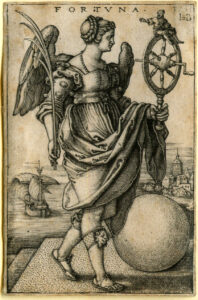
The Roman goddess Fortuna, pictured holding the Rota
The concept of the Rota Fortunae is also closely tied to the concepts of astrology, and the rotation of the “wheel” of zodiac signs which “rotates” across the sky. In many illustrations, the Rota Fortunae wheel is depicted with 12 spokes, in a reference to the 12 signs of the zodiac.
The Rota Fortunae in Tarot
When hand-painted Tarot cards first made their appearance in the 15th century, the Rota Fortunae was included as a core symbol in the earliest known decks. The seminal Visconti-Sforza cards, which date back to the 15th century show clearly that the Wheel of Fortune symbol was considered important enough to be included in the very first editions, alongside “The Pope“, “The Sun“, “The Moon” and “Death” Tarot cards.

The “Wheel of Fortune” card from the Visconti-Sforza Tarot decks (15th century)
Today, the most widely known depiction of the Rota Fortunae is the “Wheel of Fortune” Tarot card from the well-known Rider-Waite Tarot deck. This particular illustration (shown below) also references an interesting anagram of the letters ROTA (referencing the Rota Fortunae), which also spell TAROT in a clockwise direction, and TORA (as in the Torah, or the first 5 books of the Hebrew Bible), when read right-to-left like Hebrew. (This cryptic spelling of Torah without the final ‘h’ also appears on the High Priestess card).
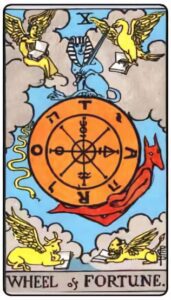
The Rider-Waite “Wheel of Fortune” Tarot card is based on the historic Rota Fortunae
Understanding the historic meanings of the Rota Fortunae, can add meaning to the Wheel of Fortune card in any Tarot reading. The Rota suggests not only that fate is unknowable, but that it can spin both ways. Power and success are not permanent states of affairs, but neither are poverty or loss.
It was the Greek philosopher and playwright Sophocles who said it best:
Chance raises a man to the heights, chance casts him down, and none can foretell what will be from what is.
— Sophocles (from Antigone)
Next time the Wheel of Fortune turns up in a Tarot reading, remember it’s a symbol far older than the Tarot illustrations on your cards. It’s a concept that’s been with us for a very long time.
Have you tried iFate’s Free Tarot readings? Try one now, it’s easy and free!



